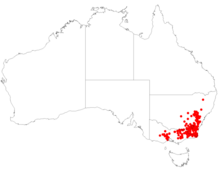| Digger's speedwell | |
|---|---|

| |
| Scientific classification | |
| Kingdom: | Plantae |
| Clade: | Tracheophytes |
| Clade: | Angiosperms |
| Clade: | Eudicots |
| Clade: | Asterids |
| Order: | Lamiales |
| Family: | Plantaginaceae |
| Genus: | Veronica |
| Species: | V. perfoliata |
| Binomial name | |
| Veronica perfoliata R.Br. | |

| |
| Occurrence data from Australasian Virtual Herbarium | |
| Synonyms | |
| |
Veronica perfoliata, commonly known as digger's speedwell, is a common perennial herb found at higher altitudes in south-eastern Australia. It is a low-growing multi-stemmed plant rising from a woody rootstock. It has rounded blue-grey foliage and sprays of intense violet-blue flowers at the end of arching branches. It is occasionally cultivated as a garden plant.
Description


Veronica perfoliata is an erect woody herb with arching decumbent branches 120 cm (47 in) long. The leaves are smooth and bluish green with a powdery bloom, about 1.5–5.5 cm (0.59–2.2 in) long and 15–40 mm (0.59–1.6 in) wide. Leaves are either narrow or broad egg-shaped and arranged in opposite pairs, joined to the stem either in a wedge, heart, or stem-clasping configuration. The leaf margin may be entire, finely scalloped or with approximately 10 pairs of rough or shallow sharp teeth. Plants with narrower leaves generally grow in drier situations, whereas the broad-leaf form in wetter cooler locations. Leaves have 3-9 longitudinal veins radiating from the base. Numerous woody stems grow from a rootstock and form a clump, rarely branched below the inflorescence.
The inflorescence is a slender raceme, 10–45 cm (3.9–18 in) long with 25–70 flowers per stem. When fruiting the pedicel is 5–12 mm (0.20–0.47 in) long. The smooth calyx lobes are 3–5 mm (0.12–0.20 in) long and 0.5–1 cm (0.20–0.39 in) wide. The individual violet-blue flower petals are 7–12 mm (0.28–0.47 in) long. The seed capsules are egg-shaped 4.5–8.5 mm (0.18–0.33 in) long and 2.8–3.5 mm (0.11–0.14 in) wide. Capsules are barely flattened, dull, and either rounded or sharply pointed. Flowering occurs from October to February.
Taxonomy and naming
Robert Brown first formally described the species in 1810, using V. perfoliata, in the botanical survey Prodromus Florae Novae Hollandiae. Constantine Rafinesque, Barbara Briggs and Friedrich Ehrendorfer changed the name to Parahebe perfoliata or Derwentia perfoliata, but the changes have not been accepted by the Australian Plant Census. The specific epithet (perfoliata) refers to the plant having "perfoliate" leaves, where the stem appears to be passing through the leaves. The common name "digger's speedwell" derives from a belief that the species is a reliable indicator of the presence of gold. "Speedwell" is a name for several species of veronica.
Distribution and habitat
Digger's speedwell grows at higher altitudes between 530–1,780 m (1,700–5,800 ft) high in mountainous meadows, heath, eucalypt forest, and woodland in New South Wales, the Australian Capital Territory, and Victoria. It grows in similar areas to V. derwentiana but in shallow, often rocky soil on steep slopes rather than deeper soils in shaded sites. The broad range of the species contrasts with the belief that it indicates the presence of gold.
References
- ^ "Veronica perfoliata". Australian Plant Census. Retrieved 13 April 2019.
- ^ Briggs, Barbara G.; Makinson, Robert O. "Veronica perfoliata". Royal Botanic Garden Sydney. Retrieved 13 April 2019.
- ^ Ng, Prudence. "Veronica perfoliata". Growing Native Plants. Australian National Botanic Gardens. Retrieved 13 April 2019.
- ^ Sheather, Warren; Sheather, Gloria. "Veronica perfoliata". Australian Plant Society. Retrieved 13 April 2019.
- ^ Wrigley, John W.; Fagg, Murray (2001). Australian Native Plants. Louise Eggerton-Reed New Holland. ISBN 1-876334-30-4.
- Fairley, Alan; Moore, Philip (2010). Native Plants of the Sydney Region. Jacana Books-Unwin & Allen. ISBN 978-1-74175-571-8.
- "Veronica perfoliata". APNI. Retrieved 13 April 2019.
- Brown, Robert (1810). Prodromus florae Novae Hollandiae et Insulae Van-Diemen. p. 434. Retrieved 13 April 2019.
- ^ Briggs, Barbara G.; Ehrendorfer, Friedrich F. (30 September 1992). "A revision of the Australian species of Parahebe and Derwentia (Scrophulariaceae)". Telopea. 5 (1): 280–284. doi:10.7751/telopea19924967.
- Moore, Bruce, ed. (1999). The Australian Oxford dictionary. Oxford University Press. p. 1295. ISBN 0195507932.
- Cosgrove, Meredith (2014). Photographic Guide to Native Plants of the Australian Capital Territory. Meadow Argus. ISBN 9780994183408.
- "Veronica perfoliata". VicFlora. Royal Botanic Gardens Victoria. Retrieved 13 April 2019.